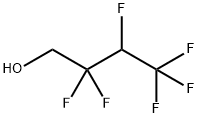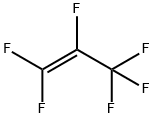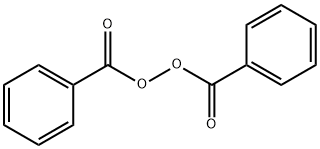
2,2,3,4,4,4-HEXAFLUORO-1-BUTANOL synthesis
- Product Name:2,2,3,4,4,4-HEXAFLUORO-1-BUTANOL
- CAS Number:382-31-0
- Molecular formula:C4H4F6O
- Molecular Weight:182.06

67-56-1
733 suppliers
$7.29/5ml-f

116-15-4
160 suppliers
$40.00/25 g

382-31-0
189 suppliers
$7.00/25g
Yield:382-31-0 67%
Reaction Conditions:
with diisopropyl peroxydicarbonate at 40 - 100; under 10498.4 - 45820.5 Torr; for 21 - 36 h;
Steps:
1; 2; 3; 4; 5; 1; 2 EXAMPLE 1
To a mixture of 240 g of methanol and 3 g of a free radical initiator, Luperox IPP, sold by ELF Atochem, Inc. (containing 27-28% of di-isopropyl peroxydicarbonate) in a 600-ml autoclave, 370 g of hexafluoropropene was added after degas thereof. Nitrogen was then introduced to the autoclave until the pressure therein reached 263 psi. The mixture in the autoclave was heated to 50° C. in 10 minutes, and the pressure was increased slowly to 287 psi right after the heating. The temperature was maintained at 50° C. for reaction for 24 hours by heating. During the reaction nitrogen was supplied to the autoclave when the pressure therein dropped below 250 psi, and the nitrogen supply was cut off when it was back up to 300 psi. The reaction mixture was removed from the autoclave after the reaction, and distilled. The distilled product collected at 114-118° C. is 90 g. EXAMPLE 2 [0017] To a mixture of 240 g of methanol and 4 g of Luperox IPP in a 600-ml autoclave, 370 g of hexafluoropropene was added after degas thereof. Nitrogen was then introduced to the autoclave until the pressure therein reached 290 psi. The mixture in the autoclave was heated to 5° C. in 10 minutes, and the pressure was decreased to 285 psi right after the heating. The temperature was maintained at 50° C. for reaction for 24 hours by heating. During the reaction nitrogen was supplied to the autoclave when the pressure therein dropped below 250 psi, and the nitrogen supply was cut off when it was back up to 300 psi. The reaction mixture was removed from the autoclave after the reaction, and distilled. The distilled product collected at 114-118° C. is 100 g. EXAMPLE 3 [0018] To a mixture of 240 g of methanol and 10 g of Luperox IPP in a 600-ml autoclave, 368 g of hexafluoropropene was added after degas thereof. Nitrogen was then introduced to the autoclave until the pressure therein reached 290 psi. The mixture in the autoclave was heated to 40° C. in 4 minutes, and the pressure was decreased to 229 psi right after the heating. The temperature was maintained at 40° C. for reaction for 8 hours by heating; then increased to 45° C. by heating in 20 minutes, and maintained at 45° C. for reaction for 18 hours by heating; and finally increased to 50° C. by heating in 20 minutes, and maintained at 50° C. for reaction for 10 hours by heating. During the reaction nitrogen was supplied to the autoclave when the pressure therein dropped below 220 psi, and the nitrogen supply was cut off when it was back up to 300 psi. The reaction mixture was removed from the autoclave after the reaction, and distilled. The distilled product collected at 114-118° C. is 300 g. Yield 67%. EXAMPLE 4 [0019] To a mixture of 240 g of methanol and 10 g of Luperox IPP in a 600-ml autoclave, 360 g of hexafluoropropene was added after degas thereof. The pressure in the autoclave at room temperature (25° C.) was 123 psi. The mixture in the autoclave was heated to 50° C. in 40 minutes, and the pressure was increased to 203 psi right after the heating. The temperature was maintained at 50° C. for reaction for 36 hours by heating. After the reaction the pressure in the autoclave dropped to 94 psi. The reaction mixture was removed from the autoclave after the reaction, and distilled. The distilled product collected at 114-118° C. is 255 g. EXAMPLE 5 [0020] To a mixture of 240 g of methanol and 10 g of Luperox IPP in a 600-ml autoclave, 290 g of hexafluoropropene was added after degas thereof. Nitrogen was then introduced to the autoclave until the pressure therein reached 296 psi. The mixture in the autoclave was heated to 40° C. in 18 minutes, and the pressure was decreased slowly to 259 psi right after the heating. The temperature was maintained at 40° C. for reaction for 22 hours by heating. During the reaction nitrogen was supplied to the autoclave when the pressure therein dropped below 230 psi, and the nitrogen supply was cut off when it was back up to 300 psi. The reaction mixture was removed from the autoclave after the reaction, and distilled. The distilled product collected at 114-118° C. is 30 g. CONTROL EXAMPLE 1 [0021] To a mixture of 240 g of methanol and 15 g of Luperox IPP in a 600-ml autoclave, 366 g of hexafluoropropene was added after degas thereof. Nitrogen was then introduced to the autoclave until the pressure therein reached 275 psi. The mixture in the autoclave was heated to 40° C. in 10 minutes, and the pressure was decreased to 243 psi right after the heating. The temperature was maintained at 40° C. for reaction for 4 hours by heating, then was increased to 60° C. in 10 minutes (pressure ramped from 250 psi to 630 psi), and maintained at 60° C. for 17 hours (pressure dropped finally to 271 psi). The reaction mixture was removed from the autoclave after the reaction, and distilled. The distilled product collected at 114-118° C. is 264 g. CONTROL EXAMPLE 2 [0022] To a mixture of 240 g of methanol and 3 g of Luperox IPP in a 600-ml autoclave, 364 g of hexafluoropropene was added after degas thereof. Nitrogen was then introduced to the autoclave until the pressure therein reached 297 psi. The mixture in the autoclave was heated slowly to 100° C. in 10 minutes, wherein the pressure was increased to 990 psi when the temperature reached 75° C., and was 886 psi when the temperature reached 100° C. The temperature was maintained at 100° C. for reaction for 26 hours by heating (pressure decreased from 886 psi to 481 psi). The reaction mixture was removed from the autoclave after the reaction, and distilled. The distilled product collected at 114-118° C. is 106 g. [0023] The results are listed in Table 1. It can be from the results of Example 1 and Control Example 2 that the yield is not enhanced by increasing the reaction temperature high than 50° C., instead the pressure in the autoclave is abruptly increased. Control Example 2 shows that the pressure in the autoclave ramps as the reaction temperature is raised to higher than 50° C. during the reaction, even though the initial reaction temperature is lower than 50° C. The results of Examples 3 and 4 indicate that the nitrogen supply for maintaining the reaction pressure can enhance the yield. It is believed that the low yield of Example 3 is due to a low reaction temperature.
References:
Chung-Shan Institute of Science & Technology US2004/89531, 2004, A1 Location in patent:Page 1-3

116-15-4
160 suppliers
$40.00/25 g

107-31-3
329 suppliers
$16.00/25mL

382-31-0
189 suppliers
$7.00/25g

104725-00-0
1 suppliers
inquiry

106538-78-7
6 suppliers
inquiry

67-56-1
733 suppliers
$7.29/5ml-f

116-15-4
160 suppliers
$40.00/25 g

94-36-0
477 suppliers
$20.60/1vl

382-31-0
189 suppliers
$7.00/25g

121-43-7
345 suppliers
$13.00/25mL

116-15-4
160 suppliers
$40.00/25 g

382-31-0
189 suppliers
$7.00/25g